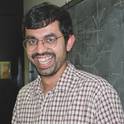
Unpublished Paper
The Red Radio Ring: a Gravitationally Lensed Hyperluminous Infrared Radio Galaxy at z=2.553 Discovered Through Citizen Science
Monthly Notices of the Royal Astronomical Society
(2015)
Abstract
We report the discovery of a gravitationally lensed hyperluminous infrared galaxy (L_IR~10^13 L_sun) with strong radio emission (L_1.4GHz~10^25 W/Hz) at z=2.553. The source was identified in the citizen science project SpaceWarps through the visual inspection of tens of thousands of iJKs colour composite images of Luminous Red Galaxies (LRGs), groups and clusters of galaxies and quasars. Appearing as a partial Einstein ring (r_e~3") around an LRG at z=0.2, the galaxy is extremely bright in the sub-millimetre for a cosmological source, with the thermal dust emission approaching 1 Jy at peak. The redshift of the lensed galaxy is determined through the detection of the CO(3-2) molecular emission line with the Large Millimetre Telescope's Redshift Search Receiver and through [OIII] and H-alpha line detections in the near-infrared from Subaru/IRCS. We have resolved the radio emission with high resolution (300-400 mas) eMERLIN L-band and JVLA C-band imaging. These observations are used in combination with the near-infrared imaging to construct a lens model, which indicates a lensing magnification of ~10x. The source reconstruction appears to support a radio morphology comprised of a compact (<250 pc) core and more extended component, perhaps indicative of an active nucleus and jet or lobe.
Keywords
- galaxies: observations,
- high-redshift,
- methods: miscellaneous
Disciplines
Publication Date
2015
Comments
Prepublished version downloaded from ArXiv. Submitted to Monthly Notices of the Royal Astronomical Society for publication.
Citation Information
J. E. Geach, A. More, A. Verma, P.J. Marshall, et al.. "The Red Radio Ring: a Gravitationally Lensed Hyperluminous Infrared Radio Galaxy at z=2.553 Discovered Through Citizen Science" Monthly Notices of the Royal Astronomical Society (2015) Available at: http://works.bepress.com/gopal_narayanan/14/
